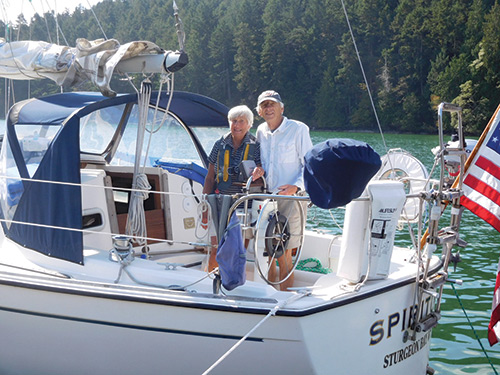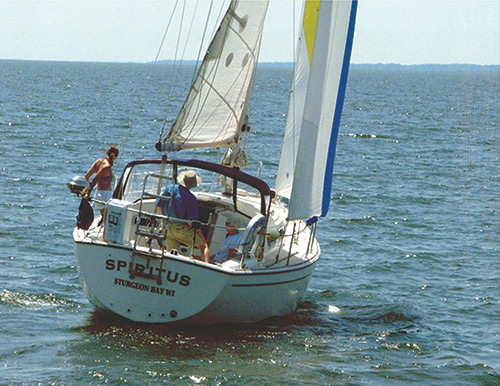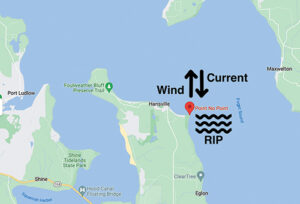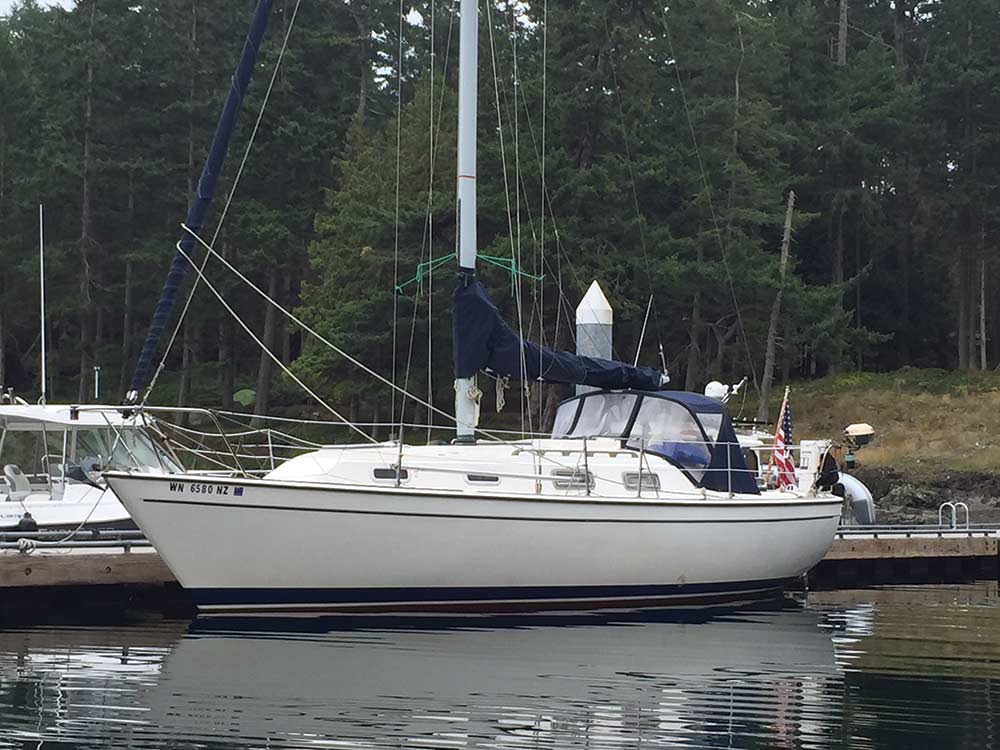PNW Sailors Find Out That This Notorious Tide Rip Is No Joke
It was a beautiful Friday and my wife, Sandy, and I were on the way from our home port of Port Townsend to Kingston in our 1983 Pearson 303, Spiritus. We were planning to meet other members of our local yacht club and had stopped for the first night at Port Ludlow. As we headed out the next morning for the short 17 mile leg to Kingston, we had lots of sun and a nice southerly breeze, so we set the mainsail and jib and proceeded eastward on a fine beam reach toward Foulweather Bluff.
The wind freshened considerably as we made our way along this course. By the time we got past Foulweather Bluff and turned southeast to proceed down Puget Sound, the southerly wind picked up even more and was now almost directly against us, so we turned on our engine and lowered both sails. The waves, which had started out small, built quickly and were now 4 to 5 feet.

A 4- or 5-foot wave may not sound like much but, in these inland waters, especially when they are steep and close together, heading into such waves makes for a rough ride. With each wave, the bow would rise way up, and then come down suddenly with a crash. Sandy, who generally never complains about sea conditions, said at one point, “This is really not fun!” I had to agree.
Little did we know, however, that by far the worst of the experience was yet to come. Point No Point lies on the west side of Puget Sound about 4 miles southeast of Foulweather Bluff. Home to an iconic lighthouse, it was given this name by Charles Wilkes during the United States Exploring Expedition of Puget Sound in 1841, because the point appears much less of a promontory at close range than it does from a distance. We knew that it was normal to encounter tide rips in the vicinity of this point, but had been through the area with the boat a number of times before and found the rips to be mild and nothing of concern.
I had not, however, noticed the following admonition in the Waggoner Cruising Guide: “Watch out for this tide-rip. When a strong wind opposes a big tide, the waters off Point No Point can turn dangerous.”
We were in fact being pushed south by a sizable flood tide, making 7 or 8 knots toward our destination while fighting a 20-25 knot southerly — exactly the troublesome situation described by the cruising guide. I was concentrating so much on pushing through the ugly sea state that I frankly forgot all about the tide rip. Usually you can see a significant tide rip from a distance, with its standing waves, and take steps to avoid it. In this case, the big waves that already surrounded us completely concealed the rip ahead.

All of a sudden, we were in the rip. Waves, which were at least as high as what we had been in and probably higher, instead of marching along in orderly fashion, began hitting us from every direction. Spiritus was suddenly being tossed around like a cork, making it very difficult to steer. The sea state was absolutely chaotic. Throughout my many years of sailing, I had never been in anything like it, and it was probably the most frightening situation I had encountered on a boat. I was hoping and praying that Spiritus’ faithful diesel engine would keep going through it all.
As a sailor, you want to at least feel that you are in control of a situation, or at least working in concert with the conditions. In this case, I did not have that feeling.
Amazingly, through all of this churning chaos, the south-going tidal current was so strong that our GPS showed us continuing toward Kingston at a steady 7-8 knots over the ground. Even so, the rip seemed to take forever for us to get through. Eventually, we did get out of the rip, and, thankfully, the strong wind soon moderated as well. We had a pleasant ride the rest of the way to Kingston.

When we got into port at Kingston and met up with our friends, we were definitely ready for a drink! We found out that another boat from our club, a 36-foot sailboat, had been in the rip at a similar time to when we were there, but farther out from shore. They had left a forward hatch open and a wave had come over their bow, gone down the deck, and soaked their main cabin. Not a fun moment, I’m sure. All of this reinforced the idea that this rip is not to be taken lightly.
That night, we had a fine party on the dock in Kingston with the yacht club group, at which almost everybody talked about their own miserable experiences in the rip that day. After a relaxing Saturday, we headed home on Sunday morning in very light wind. Though we had to motor the whole way back to Port Townsend, we had a nice ebb tide pushing us northward. As we passed Point No Point, we marveled at the difference in the area from two days prior. A host of small fishing boats were pleasantly trolling through the same place where the breathtaking rip had wreaked havoc for us, and the calm water was disturbed only by a few scattered ripples. Hard to believe it was the same place!
We certainly gained a new respect for the Point No Point rip on that trip. And, while I had long been aware of the hazard that a strong current running against a strong wind can create, I had not fully appreciated that hazard until this experience. We learned that a dangerous rip can be concealed from you if you are in rough water before you hit it.
As cruisers, it is important to be prepared for the harsh conditions we may encounter on the water. Still, even ample preparation can leave a big delta between our expectations and reality. It’s part of what makes the activity of cruising the Salish Sea so rewarding — this pursuit provides lifelong learning opportunities, dynamic new experiences, and the chance to deepen our understanding of and respect for these spectacular waters. When an experience underway surprises us by being far less pleasant than we’d envisioned, it can still serve to show us how we might take steps to ensure an even better time when we untie our dock lines next.

Mike Smith is a retired attorney who has been sailing since he was a teenager, starting with racing in his hometown of Muskegon, Michigan. In 2009, he and his wife, Sandy, had Spiritus trucked from Green Bay, Wisconsin to Port Townsend. Between Lake Michigan and the Pacific Northwest, they have put about 4,000 nautical miles on her. Feature photo by Jonathan Miske.
Mike Smith
Mike Smith is a retired attorney who has been sailing since he was a teenager, starting with racing in his hometown of Muskegon, Michigan. In 2009, he and his wife, Sandy, had Spiritus trucked from Green Bay, Wisconsin to Port Townsend. Between Lake Michigan and the Pacific Northwest, they have put about 4,000 nautical miles on her.






